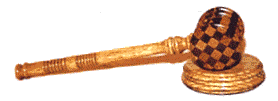
| Art |

|
| Woman's satin shoe Back in the day, London became a hotspot for development of women's footwear. Many early styles went for export to the Colonies. This specific shoe, made of pink satin, was credited as being "Made by John Hose at the Rose in Cheapside near Milk Street, London"* during the 1740s. Take note: the English style embodies the "thick curved heel and pointed upturned toe."* A buckle generally would accompany such a shoe. *http://www.mcny.org/footnotes/shoe2.htm |
Current Price: 18 pounds |
| The Blue Boy An interesting itemIthe child in the painting wears the item for sale, a set of clothing that actually went out of style rather quickly in England. Children in England did not wear this style, though many assume it to be a standard. However, this painting (by the artist Gainsborough) is a "result of a short-lived fashion in England in the 1760's-1780's for having one's portrait painted in dress from the previous century pulled out of trunks in the attic, much the way today people get themselves photographed in sepia colors in Wild West clothing."* *http://www.costumes.org/pages/18thchil.htm |
Current Price: 28 pounds |
| Wax Portrait A STEAL! No foolsIthis is an original. Made out of wax, this portrait depicts the famed stage actor David Garrick, who lived between the years 1717 and 1779. Reknowned on the English stage as one of the best actors of the 18th Century, Garrick's career began when he became friends with the writer Samuel Johnson. The two went off to London and Garrick landed the classic Shakespearean role of Richard III. Other plays would come, most notably King Lear. He also starred in Hamlet, The Tempest, A Winter's Tale, The Taming of the Shrew and an adaptation of Samuel Richardson's Pamela. He was an innovator at the Drury Lane Theater. A rebellious performer onstage, this item is a must have for any theatre goer or lover. *http://www.encyclopedia.com/articles/04933.html, http://shakespeare.eb.com/shakespeare/micro/227/51.html |
Current Price: 10 pounds |
| Embroidery A popular activity for many English female servants, the task of embroidery developed the artistry of the woven pattern in popular cirlces. Women would usually use a nice wool (if affordable) to create their designs. The pictured pattern was "the perfect recptable to embroider the scrolling floral motifs popular on the items or clothing." Dated: 1700 * http://www.witneyantiques.com/flat.items/embroidery2.htm |
Current Price: 5 pounds |
| Salon Chair Used more as a decorative aesthetic to a fancy room, a salon chair usually could be found on the edges and corners of a room for small, private conversation between women or gents. Often, the designer of these chairs (such as the one above) would line the legs and frame with gold trim. The rear legs bending backwards comes as a standard for the Salon chair. * http://www.witneyantiques.com/solid.items/chairs.htm |
Current Price: 13 pounds |
| Sewing Box An item of necessity for most mothers and female house servants. Great for storage of sewing/seamstress items. This piece comes assembled entirely out of mahogany. The riveted trim laid along the edges of the box signifies a characteristic of the 18th Century English design. Though its origin remains unknown, dates show that the box was made between 1780 and 1790. *http://www.antiques--art.com/items/6308/item6308store.html |
Current Price: 8 pounds |
| Mereworth Castle An original engraving by Vitruvius Britannicus, dating back to 1725. This piece is a beautiful rendition of the architect Colen Campbell's design of the Mereworth Castle, "one of the earliest statements of the English Palladin movement." *http://www.Tulane.EDU/lester/text/18thCentury/English.Style/English.Style8.html |
Current Price: 25 pounds |
| English Perfume bottles Though weathered a bit (these bottles went on a tour through the countryside of Toledo in Spain), the English Perfume bottles are a wonderful piece of craftsmenship. Hand designed gold cagework surrounds the two bottles, which both come filled with aged agate perfume. The case that the bottles come in is made of shagreen. Dated: 1765. Great as gift for wife/mistress. *http://www.antique-art.com.au/gallery/items/2544.html |
Current Price: 2 pounds |
| Quarrels with her Jew Protector Part of Hogarth's Harlot's Progress series (there were 6 etchings total), this piece may be the most famous and reknowned of them. Measuring 12 inches by 15 inches, the artist rendered a story of the day in the life of a Harlot from the original procuring to the act and on to her arrest and her death. A total of 1240 sets of this series were made, making this piece a highly collectable item. * http://www.haleysteele.com/hogarth/plates/harlot.html |
Current Price: 200 pounds |
| Strolling Actresses Dressing in a Barn This gorgeous original print (1738) from the artist William Hogarth conveys his style in the Eighteenth Century of working within the confines of the stage and the theater. Hogarth's depiction of the body and its movements seems to be exentuated in the central figure in this portrait. Centered within the frame, the actress is a artifice of movement, her legs contorted in different ways while one arm raises and the other draws closer toward the torso. The anxious ripples in the cloth create energies of motion. This piece is classic Hogarth. *http://www.library.nwu.edu/spec/hogarth/ |
Current Price: 50 pounds |
Back to Ye Old eBay Index